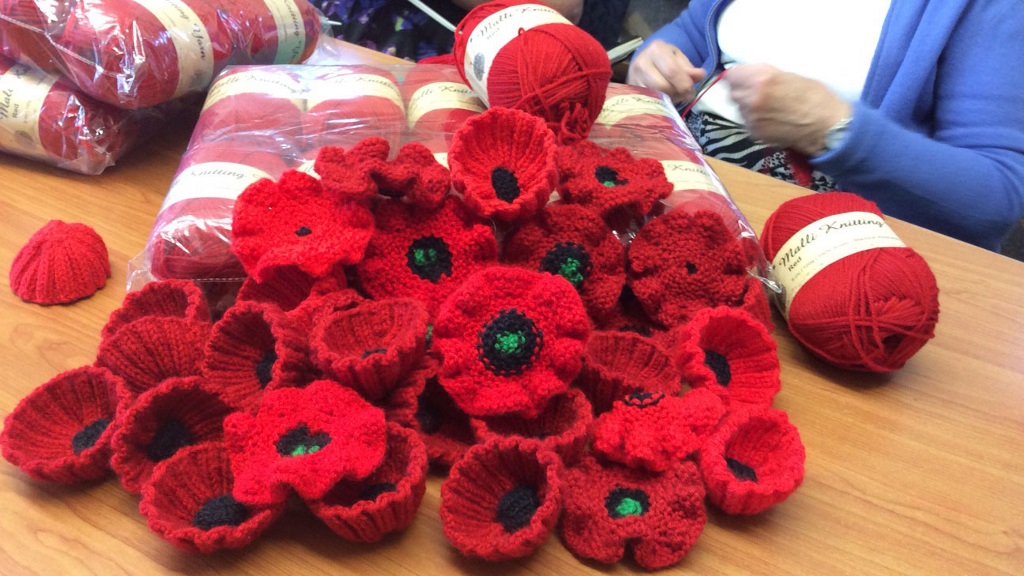More than 30 trees in 21 townships and communities across Waikato District will start to ‘flower’ with more than 6,000 red knitted poppies this weekend in time for ANZAC Day.
Nearly 2,000 more poppies, crafted from felt and yarn, will bloom along the northern stretch of Te Awa: Great New Zealand River Ride cycleway at Ngaruawahia and across the Perry Bridge over the Waikato River.
Community groups have taken up the challenge for a second year to hand-craft the poppies for a district-wide ‘yarn bombing’ street art project to commemorate ANZAC Day this year to mark the international First World War Centenary, WW100 New Zealand.
Knitters from school age to retirement age have taken up the idea put forward by the Waikato District Council Placemaking Team to join with community groups and local Community Houses to decorate prominent trees in each town for the month of April.
Mayor Sanson says, “Our grandmothers knitted garments to help to keep our ANZAC troops warm, and so we’re bringing history into the present-day by following the latest international trend to use yarn to create community-friendly street art.”
The effort has grown from nine communities last year to 20 communities this year, and will even spread to Waiouru where poppy-covered ANZAC blankets knitted on giant needles by children at five primary schools in Waikato district have been turned into ‘camouflage nets’ to decorate the Centurion and Scorpion tanks outside the National Army Museum on State Highway 1.
Groups in Eureka, Glen Massey, Glen Murray, Huntly, Mangatangi, Mangatawhiri, Maramarua, Matangi, Naike, Ngaruawahia, Pokeno, Port Waikato, Puketaha, Raglan, Tamahere, Taupiri, Tauwhare, Te Kauwhata, Tuakau, Waingaro, and Waitetuna, have been enthusiastically knitting for the past month and the first of many trees will start to ‘blossom’ from Saturday 14 April onwards. These will reflect the individual interpretations of each community. Last year, for example, there was a driftwood tree at Port Waikato, a red flowering cabbage tree in Raglan, and a giant oak tree at Matangi.
The camouflage nets for the army tanks at Waiouru were created by children at Te Uku School near Raglan, Kimihia Primary School in Huntly, Waingaro School, Taupiri School and Tuakau Primary School who learned how to knit them last year as they also learned about the history of ANZAC Day and how families at home would knit garments for the troops overseas.
Council staff have also joined the fray to knit poppies to decorate a tree and create an art installation at the Council. They have been assisted by prisoners at Spring Hill Corrections Facility who have created plywood art cutouts of a tank, ship and warplane representing the troops who served and died, together with other representations of those who remained at home.
The idea to knit poppies originated from a small project started by two Australian women that ballooned into a massive carpet of 300,000 red knitted poppies created by 50,000 volunteers for the Chelsea Flower Show in the UK in May 2016. That project then spawned a number of local Remembrance Day projects throughout the UK to decorate churches, trees and graveyards in November.
Working with the Ngaruawahia Community House, which is supporting the project district-wide, the Waikato District Council’s Placemaking Team set the ball rolling as an ANZAC commemoration project last year and decided it was so popular it was worth repeating. They distributed starter packs of wool to groups taking part, and volunteers have contributed more wool to bring the concept together.
The Council’s Placemaking Team was established to support and encourage residents to reclaim their public spaces for community use. Information about ‘placemaking’, the philosophy behind it and the advantages it brings to the community can be found on the Waikato District Council website (search for ‘placemaking’ on the site), or by contacting the Waikato District Council community placemaking team Betty Connolly (Betty.Connolly@waidc.govt.nz) and Lianne Van Den Bemd (Lianne.VanDenBemd@waidc.govt.nz).
Photograph: Poppies created by the Raglan Knitting Group have been draped on trees close to the Raglan Cenotaph in Bow St. Thanks to Richard Gallagher for the image.




